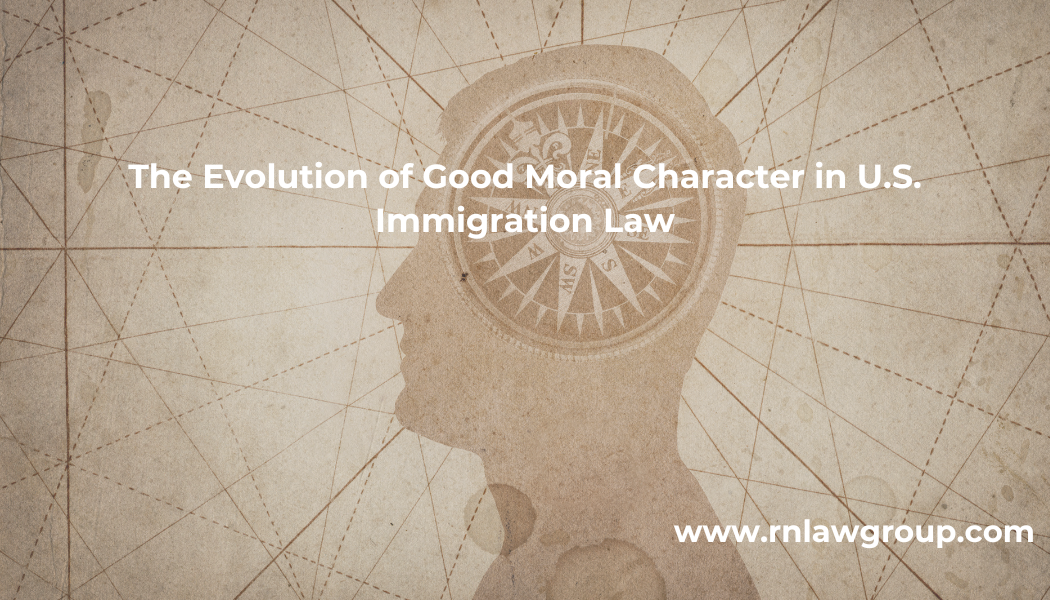
The Evolution of Good Moral Character in U.S. Immigration Law
The notion of “good moral character” (GMC) has served as a fundamental principle of U.S. immigration law for more than a century, although its interpretation and implementation have evolved alongside changing legal structures and societal values. Its origins trace back to the late 1800s, when Congress initiated the exclusion of immigrants deemed undesirable on moral grounds. The Immigration Act of 1891 prohibited individuals likely to become a “public charge,” those convicted of crimes involving “moral turpitude,” and others considered socially unfit. Although the term “good moral character” had not yet been codified, the principle that morality should influence who could integrate into American society was firmly established. The Immigration Act of 1906 officially incorporated GMC into legislation by mandating that citizenship applicants demonstrate they had maintained good moral character for a minimum of five years prior to naturalization, thus embedding morality as a criterion for inclusion in the national community.
In the initial decades of the twentieth century, GMC was primarily defined by judges and immigration officials who depended on community testimonials and prevailing social norms. Naturalization applicants could face denial for actions such as adultery, habitual drunkenness, or perceived political radicalism. Courts wielded considerable discretion, often mirroring the biases and cultural expectations of the era. This rendered GMC a versatile yet inconsistent instrument, permitting local authorities to decide who was considered “worthy” of citizenship. By the mid-twentieth century, GMC had become firmly established in naturalization law, yet the lack of a uniform definition frequently led to arbitrary or discriminatory outcomes. The requirement focused less on specific legal criteria and more on adherence to mainstream social and moral standards.
A pivotal moment occurred with the Immigration and Nationality Act of 1952, commonly referred to as the McCarran–Walter Act, which formalized the concept of Good Moral Character (GMC) by enumerating categories of individuals who could not be regarded as possessing such character. These legal exclusions encompassed habitual drunkards, individuals involved in prostitution, those convicted of specific offenses, and persons who provided false testimony for immigration purposes.
The Act also established a catch-all clause, granting adjudicators the authority to deny GMC to individuals who did not fit into these specified categories but whose actions were considered morally deficient. This legal framework provided a foundation for GMC while allowing considerable latitude for interpretation, enabling it to evolve in response to shifting societal norms. Furthermore, the 1952 Act broadened the application of GMC beyond naturalization to other contexts, such as suspension of deportation, thereby ensuring its significant role in both acquiring and maintaining lawful status.
In the subsequent decades, courts and immigration officials further developed and clarified the definition of GMC through judicial rulings and administrative actions. The associated notion of ‘crimes involving moral turpitude’ (CIMTs), first articulated in the 1890s, became closely associated with GMC assessments. Courts determined that convictions for CIMTs signified a deficiency in GMC, even when the actions did not directly correspond with the statutory exclusions. Additionally, rulings emphasized that GMC evaluations could include lawful yet socially frowned-upon behaviors, as seen in instances where adultery or neglecting to support dependents resulted in judgments of poor moral character. These broad interpretations illustrated the concept that GMC was more a reflection of moral standards than a purely legal criterion, influenced by contemporary cultural expectations as much as by legislative text.
The social and cultural transformations of the 1960s and 1970s significantly altered the interpretation of Good Moral Character (GMC). As American society reassessed its standards regarding sexuality, family dynamics, and individual rights, immigration adjudicators began to adopt more nuanced perspectives on behaviors that were previously deemed automatically disqualifying. For instance, homosexuality had long been viewed as incompatible with GMC, serving as grounds for exclusion or deportation; however, this perspective started to diminish due to the influence of civil rights movements and shifting public sentiment. Likewise, while adultery and illegitimacy were once common reasons for GMC denials, courts increasingly took into account the context, intent, and potential for rehabilitation. These changes illustrated the growing acknowledgment that morality is not fixed but evolves over time in accordance with changing social norms.
In contemporary times, GMC is still defined in Section 101(f) of the Immigration and Nationality Act, and immigration officials continue to depend on both statutory prohibitions and discretionary evaluations. Generally, applicants for naturalization must prove GMC for the five years preceding their application (or three years if married to a U.S. citizen), while those seeking cancellation of removal must demonstrate GMC for a minimum of ten years. The statutory prohibitions remain applicable, disqualifying individuals with specific criminal convictions, those involved in prostitution, or anyone who has provided false testimony to obtain immigration benefits. Concurrently, adjudicators maintain the discretion to deny GMC based on the ‘totality of circumstances,’ which may encompass factors such as tax compliance, financial responsibility, or community engagement. This combination of explicit statutory guidelines and extensive discretionary authority highlights the persistent conflict between legal certainty and moral evaluation within immigration law.
Currently, GMC is essential not only for naturalization but also for various forms of immigration relief, such as cancellation of removal, waivers of inadmissibility, Temporary Protected Status (TPS), and Deferred Action for Childhood Arrivals (DACA). Its significance shifts based on the situation, yet the core principle remains unchanged: immigrants are required to exhibit moral integrity and social responsibility to qualify for immigration benefits. This dual aspect of GMC—as both a protective measure for deserving applicants and a means to deny relief—highlights its pivotal role in the U.S. immigration framework. Immigration officials may evaluate factors like employment history, tax records, and letters of support, in addition to an applicant’s criminal history, to ascertain whether the GMC standard is fulfilled.
Despite its long-standing presence, the GMC requirement has encountered considerable criticism for its vagueness, subjectivity, and susceptibility to discriminatory enforcement. The broad discretion granted to adjudicators means that GMC can embody cultural biases and disproportionately affect marginalized communities. For instance, low-income immigrants may face penalties for minor criminal infractions or financial hardships, while wealthier applicants tend to evade such intense scrutiny. Detractors also contend that GMC frequently leads to a scenario of “double punishment,” where immigrants face repercussions first from the criminal justice system and subsequently in immigration processes. Additionally, the variability of moral standards raises further issues: actions once deemed immoral, like cohabitation outside of marriage, are now largely accepted, yet remnants of outdated standards can still influence immigration decisions.
Looking forward, the future of GMC in immigration law is likely to involve ongoing discussions regarding its fairness, scope, and implementation. Advocates have urged for reform, such as the removal of marijuana possession from GMC disqualifications in light of changing state laws and public sentiment. Additionally, there is an increasing focus on rehabilitation, restorative justice, and positive contributions to the community in GMC assessments, indicating a shift towards perceiving character as fluid rather than static. Nevertheless, GMC will almost certainly continue to be a fundamental aspect of U.S. immigration law, due to its statutory foundation and its symbolic significance as a representation of the moral standards anticipated from those wishing to become part of the national community.
The historical context of GMC in immigration law illustrates how the United States has aimed to articulate its national identity not only through legal and economic frameworks but also through moral considerations. From the initial implementation of character-based exclusions to its formalization in the 1952 Immigration and Nationality Act and its persistent application today, GMC has served as a gatekeeping tool that mirrors the nation’s shifting moral principles. Although frequently criticized for its ambiguity and potential bias, it remains integral to the equilibrium that immigration law strives to achieve between inclusion and protection, fairness and discretion, as well as individual rights and collective values. As American society continues to progress, so will its interpretation of what constitutes a person of good moral character, ensuring that this long-standing concept continues to influence immigration outcomes well into the future.
By: Karim Jivani
Karim Jivani is an Associate Attorney at Reddy Neumann Brown PC who focuses on employment-based non-immigrant visas. Karim’s practice covers all phases of the EB-1A and EB-2 NIW visa process including filing petitions, responding to Requests for Evidence (RFE), and drafting motions and appeals. Karim has also worked on all aspects of H-1B, L-1, I-140, and VAWA petitions.

